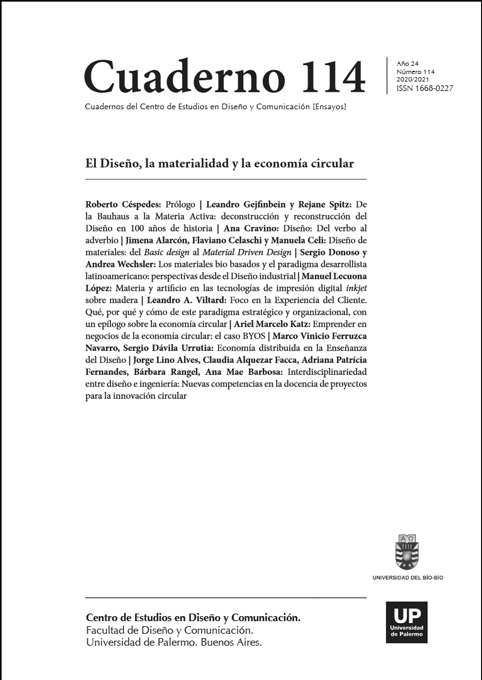Economía distribuida en la Enseñanza del Diseño
Abstract
Designing for people, their environment and their situation also means changing the approach towards human beings, their experiences and their context. It is necessary to go from a change in unconscious development, that is, only due to increased productivity, to conscious considering the cycles of the elements and their impact in the future. Design careers likewise have undergone a shift in focus from object to subject. The problems’ complexity gives designers more possibilities of development, but the limits of the discipline are more blurred. This work explores the link between design education and distributed economy based on the concepts proposed by Ezio Manzini, Brown's emerging theory, and Diamandis' exponential thinking. Because of that, several design exercises and experiences are reviewed. The intention is to achieve a better understanding of how these concepts contribute to projecting more strategic design solutions ad hoc for new development models such as distributed economies.
References
Atkinson, Paul (2011) “Orchestral Manouvers in Design” en Open Design Now. Bas van
Abel, Lucas Evers, Roel Klassen, y Peter Troxler. BIS Publishers, Premsela, Waag Society. PaísesBajos.
Boal, Augusto (1998) Legislative Theater. Routledge. New York, USA.
Brown, A. M. (2017). Emergent Strategy: Shaping Change, Changing Worlds.
Diamandis, P., Kotler, S. (2015). BOLD: How to go big, create wealth, and impact the world. Simon & Schuster Paperbacks. (2016 ed.) Ezio Manzini “Design, When Everybody Designs” MIT Press, USA, 2015
Escobar, Arturo. (2018) Designs for the Pluriverse: Radical Independence, Autonomy, and the Making of Worlds. Duke University Press.
Hoffmann, A. (2018). Impact. In Purpose & Impact (p. 256). Retrieved from https://lccn.loc.gov/2017054536
Johansson, A., Kisch, P., &Mirata, M. (2005). Distributed economies – A new engine for innovation. Journal of Cleaner Production, 13(10-11), 971-979. doi:10.1016/j.jclepro.2004.12.015
Kumar, Vijay (2013) 101 Design Methods. Ed. Wiley. USA.
Lipsod, Hod. “Fabricated: The New World of 3d Printing” (2013)
Lizarralde, I., &Tyl, B. (2018). A framework for the integration of the conviviality concept in the design process. Journal of Cleaner Production, 197, 1766-1777. doi:10.1016/j. jclepro.2017.03.108
Margolin, Victor. The Politics of the Artificial: Essays on Design and Design Studies. (Chicago: University of Chicago Press, 2002)
Sörman-Nilsson, A. (2013). Digilogue : how to win the digital minds and analogue hearts of tomorrow's customers (2013 ed.).
Thackara, John. 2004. In the Bubble: Designing in a Complex World. Cambridge, MZ. MIT Press.
Los autores/as que publiquen en esta revista ceden los derechos de autor y de publicación a "Cuadernos del Centro de Estudios de Diseño y Comunicación", Aceptando el registro de su trabajo bajo una licencia de atribución de Creative Commons, que permite a terceros utilizar lo publicado siempre que de el crédito pertinente a los autores y a esta revista.


